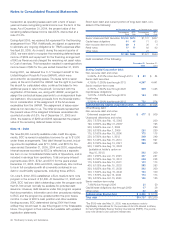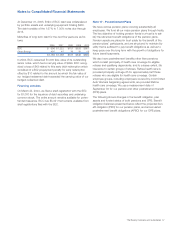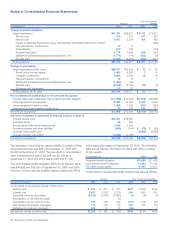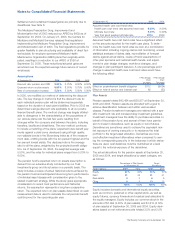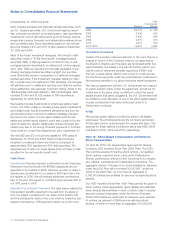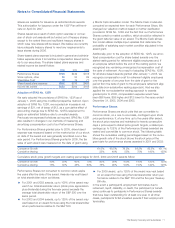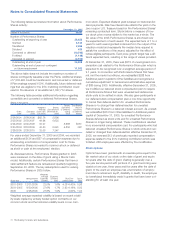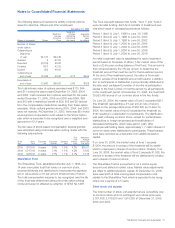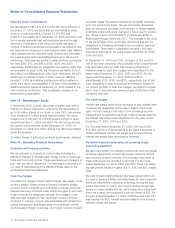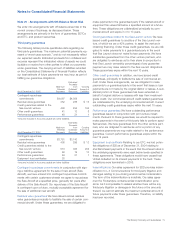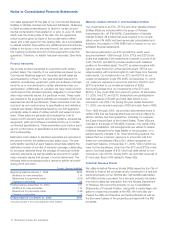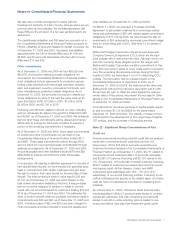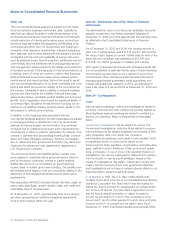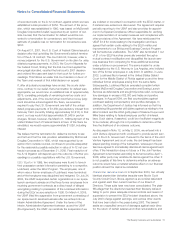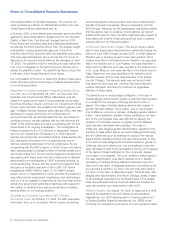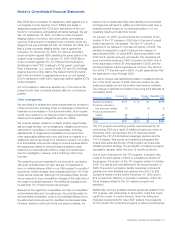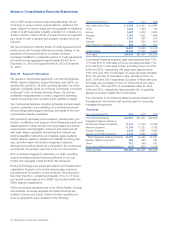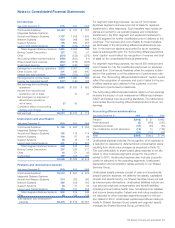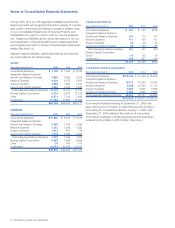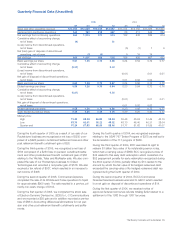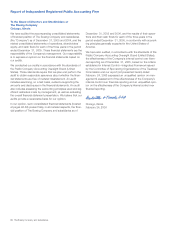Boeing 2005 Annual Report Download - page 78
Download and view the complete annual report
Please find page 78 of the 2005 Boeing annual report below. You can navigate through the pages in the report by either clicking on the pages listed below, or by using the keyword search tool below to find specific information within the annual report.
Notes to Consolidated Financial Statements
Our sales agreement for the sale of our Commercial Airplanes
facilities in Wichita, Kansas and Tulsa and McAlester, Oklahoma
to Spirit provides indemnification to Spirit for certain environ-
mental contamination that existed on or prior to June 16, 2005,
which was the closing date of the sale. Per the agreement,
notice must be given by Spirit of this contamination within
seven and a half years from the closing date. As it is impossible
to assess whether there will be any additional environmental lia-
bilities in the future or the amounts thereof, we cannot estimate
the maximum potential amount of future payments under this
guarantee. Therefore, no liability has been recorded. (See Note
24.)
Product warranties
We provide product warranties in conjunction with certain
product sales. The majority of our warranties are issued by our
Commercial Airplanes segment. Generally, aircraft sales are
accompanied by a three- to four-year standard warranty for
systems, accessories, equipment, parts and software manufac-
tured by us or manufactured to certain standards under our
authorization. Additionally, on occasion we have made commit-
ments beyond the standard warranty obligation to correct fleet
wide major warranty issues of a particular model. These costs
are included in the program’s estimate at completion (EAC) and
expensed as aircraft are delivered. These warranties cover fac-
tors such as non-conformance to specifications and defects in
material and design. Warranties issued by our IDS segments
principally relate to sales of military aircraft and weapons hard-
ware. These sales are generally accompanied by a six to
twelve-month warranty period and cover systems, accessories,
equipment, parts and software manufactured by us to certain
contractual specifications. These warranties cover factors such
as non-conformance to specifications and defects in material
and workmanship.
Estimated costs related to standard warranties are recorded in
the period in which the related product sales occur. The war-
ranty liability recorded at each balance sheet date reflects the
estimated number of months of warranty coverage outstanding
for products delivered times the average of historical monthly
warranty payments, as well as additional amounts for certain
major warranty issues that exceed a normal claims level. The
following table summarizes product warranty activity recorded
during 2005 and 2004.
Product Warranty Liabilities*
Beginning balance-January 1, 2004 $825
Additions for new warranties 114
Reductions for payments made (252)
Changes in estimates 94
Ending balance–December 31, 2004 781
Additions for new warranties 119
Reductions for payments made (146)
Changes in estimates 27
Ending balance–December 31, 2005 $781
*Amounts included in Accounts payable and other liabilities
Material variable interests in unconsolidated entities
Our investments in an ETC, EETCs and other Variable Interest
Entities (VIEs) are included within the scope of Revised
Interpretation No. 46 (FIN 46(R)), Consolidation of Variable
Interest Entities. All entities that were required to be consoli-
dated under FIN 46(R) had been previously consolidated and
therefore, the adoption of FIN 46(R) had no impact on our con-
solidated financial statements.
We have investments in an ETC and EETCs, which were
acquired between 1999 through 2005. ETCs and EETCs are
trusts that passively hold investments in aircraft or pools of air-
craft. The ETC and EETCs provide investors with collateral
position in the related asset. The ETC provides investors with
rights to cash flows from a financial instrument. EETCs pro-
vides investors with tranched rights to cash flows from financial
instruments. Our investments in an ETC and EETCs do not
require consolidation under FIN 46(R). At December 31, 2005,
our maximum exposure to economic loss from the ETC and
EETCs is limited to our investment balance of $269.
Accounting losses from our investments in the ETC and
EETCs, if any, could differ from period to period. At December
31, 2005, the ETC and EETC transactions we participated in
had total assets of $3,985 and total debt (which is non-
recourse to us) of $3,716. During the year ended December
31, 2005, we recorded revenues of $36 and cash flows of $65.
From 1998 through 2005, we provided subordinated loans to
certain VIEs that are financial structures commonly utilized by
airlines, lenders and loan guarantors, including, for example,
the Export-Import Bank of the United States. These VIEs are
included in the scope of FIN 46(R); however, only certain VIEs
require consolidation. VIE arrangements are utilized to isolate
individual transactions for legal liability or tax purposes, or to
perfect security interests or for other structuring reasons. We
believe that our maximum exposure to economic loss from
these non-consolidated VIEs is $12, which represents our
investment balance. At December 31, 2005, VIEs of which we
were not the beneficiary, other than the ETC and EETCs noted
above, had total assets of $161 and total debt (which is non-
recourse to us) of $150. During 2005, we recorded revenues of
$1 and cash flows of $6 related to these VIEs.
Industrial Revenue Bonds
We utilize Industrial Revenue Bonds (IRBs) issued by the City of
Wichita to finance the purchase and/or construction of real and
personal property at our Wichita site. Tax benefits associated
with IRBs include a provision for a ten-year property tax abate-
ment and a sales tax exemption from the Kansas Department
of Revenue. We record the property on our Consolidated
Statements of Financial Position, along with a capital lease obli-
gation to repay the proceeds of the IRB. We have also pur-
chased the IRBs and therefore are the Bondholder as well as
the Borrower/Lessee of the property purchased with the IRB
proceeds.
76 The Boeing Company and Subsidiaries


